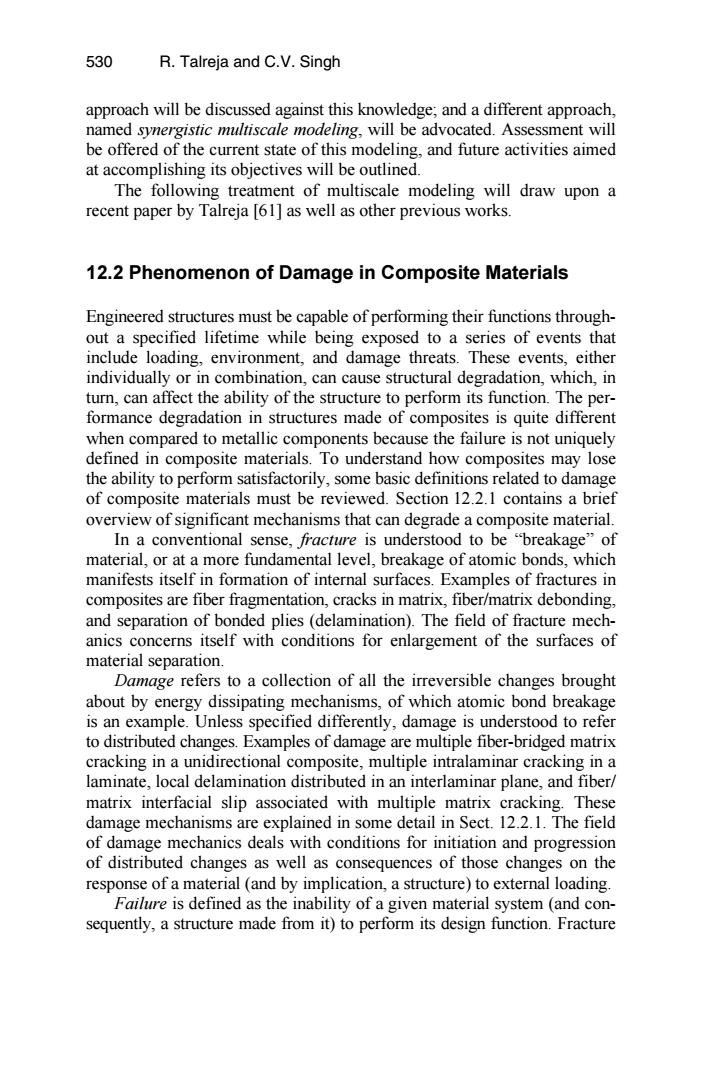正在加载图片...

530 R.Talreja and C.V.Singh approach will be discussed against this knowledge;and a different approach, named synergistic multiscale modeling,will be advocated.Assessment will be offered of the current state of this modeling,and future activities aimed at accomplishing its objectives will be outlined. The following treatment of multiscale modeling will draw upon a recent paper by Talreja [61]as well as other previous works. 12.2 Phenomenon of Damage in Composite Materials Engineered structures must be capable of performing their functions through- out a specified lifetime while being exposed to a series of events that include loading,environment,and damage threats.These events,either individually or in combination,can cause structural degradation,which,in turn,can affect the ability of the structure to perform its function.The per- formance degradation in structures made of composites is quite different when compared to metallic components because the failure is not uniquely defined in composite materials.To understand how composites may lose the ability to perform satisfactorily,some basic definitions related to damage of composite materials must be reviewed.Section 12.2.1 contains a brief overview of significant mechanisms that can degrade a composite material. In a conventional sense,fracture is understood to be "breakage"of material,or at a more fundamental level,breakage of atomic bonds,which manifests itself in formation of internal surfaces.Examples of fractures in composites are fiber fragmentation,cracks in matrix,fiber/matrix debonding, and separation of bonded plies (delamination).The field of fracture mech- anics concerns itself with conditions for enlargement of the surfaces of material separation. Damage refers to a collection of all the irreversible changes brought about by energy dissipating mechanisms,of which atomic bond breakage is an example.Unless specified differently,damage is understood to refer to distributed changes.Examples of damage are multiple fiber-bridged matrix cracking in a unidirectional composite,multiple intralaminar cracking in a laminate,local delamination distributed in an interlaminar plane,and fiber/ matrix interfacial slip associated with multiple matrix cracking.These damage mechanisms are explained in some detail in Sect.12.2.1.The field of damage mechanics deals with conditions for initiation and progression of distributed changes as well as consequences of those changes on the response of a material (and by implication,a structure)to external loading. Failure is defined as the inability of a given material system(and con- sequently,a structure made from it)to perform its design function.Fractureapproach will be discussed against this knowledge; and a different approach, named synergistic multiscale modeling, will be advocated. Assessment will be offered of the current state of this modeling, and future activities aimed at accomplishing its objectives will be outlined. The following treatment of multiscale modeling will draw upon a recent paper by Talreja [61] as well as other previous works. 12.2 Phenomenon of Damage in Composite Materials Engineered structures must be capable of performing their functions throughout a specified lifetime while being exposed to a series of events that include loading, environment, and damage threats. These events, either individually or in combination, can cause structural degradation, which, in turn, can affect the ability of the structure to perform its function. The performance degradation in structures made of composites is quite different when compared to metallic components because the failure is not uniquely defined in composite materials. To understand how composites may lose the ability to perform satisfactorily, some basic definitions related to damage of composite materials must be reviewed. Section 12.2.1 contains a brief overview of significant mechanisms that can degrade a composite material. In a conventional sense, fracture is understood to be “breakage” of material, or at a more fundamental level, breakage of atomic bonds, which manifests itself in formation of internal surfaces. Examples of fractures in composites are fiber fragmentation, cracks in matrix, fiber/matrix debonding, and separation of bonded plies (delamination). The field of fracture mechanics concerns itself with conditions for enlargement of the surfaces of material separation. Damage refers to a collection of all the irreversible changes brought about by energy dissipating mechanisms, of which atomic bond breakage is an example. Unless specified differently, damage is understood to refer to distributed changes. Examples of damage are multiple fiber-bridged matrix cracking in a unidirectional composite, multiple intralaminar cracking in a laminate, local delamination distributed in an interlaminar plane, and fiber/ matrix interfacial slip associated with multiple matrix cracking. These damage mechanisms are explained in some detail in Sect. 12.2.1. The field of damage mechanics deals with conditions for initiation and progression of distributed changes as well as consequences of those changes on the response of a material (and by implication, a structure) to external loading. Failure is defined as the inability of a given material system (and consequently, a structure made from it) to perform its design function. Fracture 530 R. Talreja and C.V. Singh